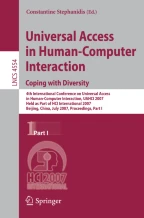Abstract
While software developers for desktop applications can rely on mouse and keyboard as standard input devices, developers of virtual reality (VR) and augmented reality (AR) applications usually have to deal with a large variety of individual interaction devices. Existing device abstraction layers provide a solution to this problem, but are usually limited to a specific set or type of input devices. In this paper we introduce DEVAL – an approach to a device abstraction layer for VR and AR applications. DEVAL is based on a device hierarchy that is not limited to input devices, but naturally extends to output devices.
Chapter PDF
Similar content being viewed by others
References
Broll, W., Lindt, I., Ohlenburg, J., Herbst, I., Wittkämper, M., Novotny, T.: An Infrastructure for Realizing Custom-Tailored Augmented Reality User Interfaces. IEEE Transactions on Visualization and Computer Graphics 11(6), 722–733 (2005)
Burdea, G., Coiffet, P.: Virtual reality technology. Wiley-Interscience, Chichester (2004)
Gadgeteer: Virtual Reality Applications Center, Iowa State University, Ames, IA (2005), http://www.vrjuggler.org/gadgeteer
Gamma, E., Helm, R., Johnson, R., Vlissides, J.: Design Patterns: Elements of Reusable Object-Oriented Software. Addison-Wesley, Reading (1995)
Kato, H., Billinghurst, M., Blanding, B., May, R.: ARToolkit. Technical Report. Hiroshima City University (1999)
Ohlenburg, J., Herbst, I., Lindt, I., Fröhlich, T., Broll, W.: The MORGAN Framework: Enabling Dynamic Multi-User AR and VR Projects. In: VRST 2004. Proc. of the ACM Symposium on Virtual Reality Software and Technology, pp. 166–169. ACM Press, New York (2004)
Pesce, M.D.: Programming Microsoft DirectShow for Digital Video and Television. Microsoft Press, Redmond (2003)
Reitmayr, G., Schmalstieg, D.: An open software architecture for virtual reality interaction. In: VRST 2001. Proc. of the ACM Symposium on Virtual Reality Software and Technology, pp. 47–54. ACM Press, New York (2001)
Rolland, J.P., Baillot, Y., Goon, A.A.: A Survey of Tracking Technology for Virtual Environments. In: Fundamentals of Wearable Computers and Augmented Reality, ch. 3, pp. 67–112 (2001)
Taylor, R., Hudson, T., Seeger, A., Weber, H., Juliano, J., Helser, A.: VRPN: A Device-Independent, Network-Transparent VR Peripheral System. In: VRST 2001. Proc. of the ACM Symposium on Virtual Reality Software and Technology, pp. 55–61. ACM Press, New York (2001)
Author information
Authors and Affiliations
Editor information
Rights and permissions
Copyright information
© 2007 Springer-Verlag Berlin Heidelberg
About this paper
Cite this paper
Ohlenburg, J., Broll, W., Lindt, I. (2007). DEVAL – A Device Abstraction Layer for VR/AR. In: Stephanidis, C. (eds) Universal Acess in Human Computer Interaction. Coping with Diversity. UAHCI 2007. Lecture Notes in Computer Science, vol 4554. Springer, Berlin, Heidelberg. https://doi.org/10.1007/978-3-540-73279-2_56
Download citation
DOI: https://doi.org/10.1007/978-3-540-73279-2_56
Publisher Name: Springer, Berlin, Heidelberg
Print ISBN: 978-3-540-73278-5
Online ISBN: 978-3-540-73279-2
eBook Packages: Computer ScienceComputer Science (R0)
